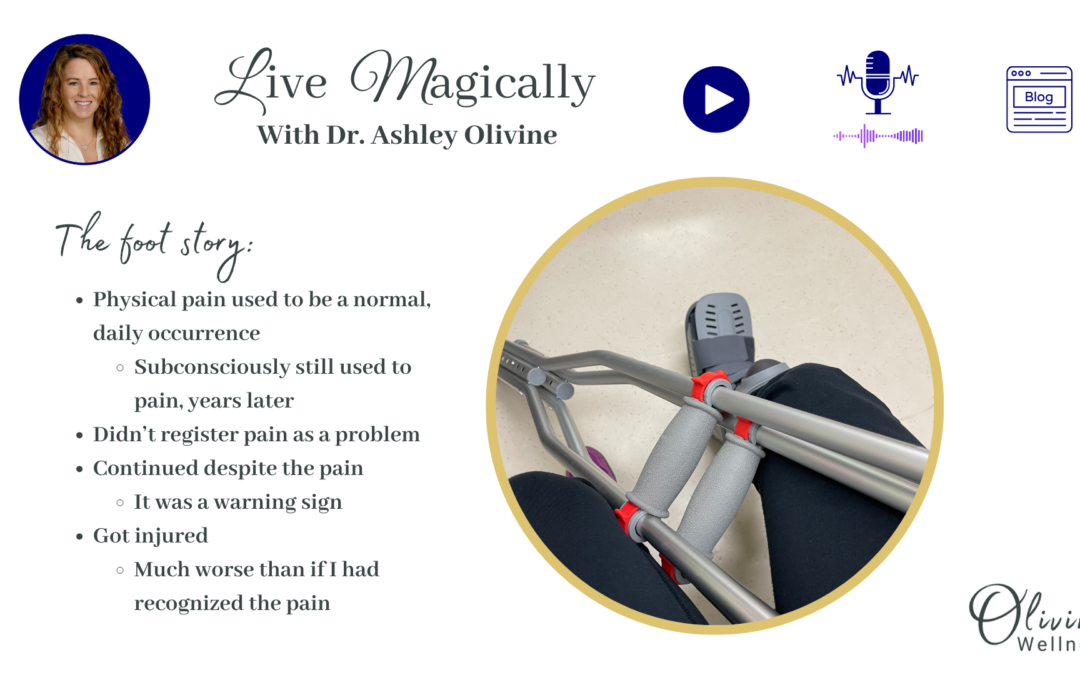I’m going to start this edition with a quick story to paint a picture of two of the biggest hidden stressors. It may seem completely irrelevant at first. Stick with me, I’ll bring it back to stress!
Awareness Prevents Harm
Let’s talk about physical pain. I have experienced a lot of it throughout the years. From brain injury and spinal cord damage to unmedicated childbirth and migraines, I am certainly no stranger to intense pain. For years I suffered from chronic pain that affected my daily life. While that is thankfully no longer my reality and hasn’t been for a long time, living with a high level of pain used to be normal for me. Apparently, that idea of physical pain being normal didn’t fully wear off. It remained in some part of my subconscious mind even after the actual, physical pain subsided. I didn’t even realize it until I broke my foot.
Breaking my foot is a silly story, really, but I have a point to it. At the time, I had been consistently running for about four years. There were times when I pushed my limits and my feet got sore. Although I experienced some minor injuries, there was nothing major that required me to stop being active.
I promise this relates to hidden stressors.
So, when I was completing my daily run, I thought nothing of my sore foot. The next day I decided to just take a short run since my food was still sore. It started hurting a lot more while running, go figure. This made no sense because it was a short run. How annoying! The idea that pain would get worse with activity was not even on my radar because not all types of pain are like that. Also, pain had previously been my normal.
I continued to run for a little while and then realized it wasn’t going to happen. Furiously, I limped home and hobbled around for the rest of the day thinking it would just go away. By the next morning, my foot was swollen and I couldn’t put any weight on it at all. I literally crawled around the house to get ready and then hopped on one foot into the ER before they got me a wheelchair. I left on crutches, which I used exclusively for months.
Believe me, I realize how ridiculous this may seem. Of course, it’s not a great idea to continue running on an injured foot. However, that level of pain didn’t register as “injured” to me until it was too late. I had already done way more damage by continuing the first day and starting again the next.
#1 Biggest Hidden Stressor: Perception
My physical foot pain was hidden from my conscious mind until it was too late. That can happen with stress, too. Hidden stressors are things that can cause stress but go unnoticed at first. Sometimes they’re seemingly small, but they add up. Other times it is clear that they are not so small, but the effect goes unnoticed.
One of the two biggest hidden stressors is a perception of stress that supports higher levels. Stress is incredibly common in modern society. It has become normal, sometimes even a right of passage. It’s almost as if we’re not doing a good job in the absence of stress, like we’re not trying hard enough.
“How’s work?”
“Stressful!”
“How have you been lately?”
“Stressed, tired.”
However, that’s not even the ‘normal’ response. In response to “How are you?” people typically reply “Good,” “Fine,” “Doing well,” or something similar. Those are the ‘normal’ responses even if the primary feeling is stress. So much is hidden behind a forced smile.
Pretending to be doing well can be a hidden stressor, too.
While I’m all for putting a positive spin on things, this can artificially make it seem as though stress and suffering are normal. While it is common, prolonged stress is not at all normal. Our bodies and minds are meant to experience stress levels that go up and down. However, many people never experience those lower levels of stress.
How stressed are you?
On a scale from 1 to 10, with 1 being completely relaxed and 10 being completely stressed, many people fluctuate from 5 to 9, for example. It makes sense, then, that 5 would feel relaxed if they’re used to 7, 8, and 9. It’s not.
For example, it is common for mothers to experience high levels of stress. Perhaps she spends her days driving kids to school and activities, striving to meet work deadlines, and cleaning up bodily fluids. Exercise has become a rarity. Showering is a privilege, and is generally interrupted at least once because someone needs help or has a question. It feels like the pinnacle of relaxation when someone is available to watch the kids while she goes to the store alone. No one is screaming, fighting, or asking anything of her at this moment.
However, the expectations of her are still weighing heavily. Some of those expectations come from herself. They are expectations that weigh heavily just the same. The thoughts are still flowing through her mind a mile per minute. What does she need to remember to buy for school lunches? Is there a plan for dinner tonight, and what ingredients are needed? The pharmacy, don’t forget, she needs to pick up a prescription. That reminds her that she needs to make an appointment. Will that mean she needs to take a day off work? If so, what about that project deadline?
All of these examples are hidden stressors.
The stress of health concerns and work and everything else is still there because she hasn’t had a free moment to process thoughts and feelings. Doesn’t seem like a luxurious, relaxing trip to the store, does it? However, that’s as relaxed as she ever gets because life keeps happening. Even when she gets in bed to go to sleep her mind is still going. That’s more hidden stress. She has built up a high tolerance for stress. It’s to the point where she doesn’t even notice those small stressors.
Are you noticing the similarities between this example and my foot pain? It’s all about perception. We won’t know what low levels of stress feel like if we consider it ‘normal’ to operate at a 5 to 10. There can be a lot of stress that piles up. It causes a lot of physical, mental, and emotional damage as it escalates unknowingly. Just like my physical pain escalated, without really being noticed, until I couldn’t walk, stress can, too. That’s called burnout.
Let’s find the hidden stressors and decrease the stress level.
So, what did I do about my pain situation? Well, first I let it heal. I built up my awareness by checking in. Routinely, I check in with my body to see if anything feels ‘off’ even if it isn’t registering as actual pain. I even seek professional support by getting things checked out to make sure they’re not injured. When in doubt, I make the appointment instead of powering through. Also, I focus on recovery. This includes stretching, sleep, and anything that helps the body to repair.
Stress is similar. We can check in with ourselves regularly and make time for things that lower stress levels. Professional support is available, too. It’s not just for mental health diagnosis. Everyone with a brain can be affected. Working with a professional to reduce and prevent stress can help to prevent burnout and other negative effects. Focusing on repair and recovery may look like relaxation exercises and prioritizing sleep. It can also take the form of a hobby or spending quality time with family and friends.
If you would like a great tool to help, I have a free relaxation exercise available HERE.
#2 Biggest Hidden Stressor: Lack of Alignment
The other of the two biggest hidden stressors is a lack of alignment. Anything we’re doing that is not aligned with our goals, beliefs, values, and current phase in life can lead to stress. For example, taking a vacation is often considered a great way to relieve stress. However, if the kids are not grounded and regulated enough to embrace a trip, or if there are big career goals taking priority, vacations can be hidden stressors. Working in a career that is less than ideal if the money is not needed and parenting in a way that is not authentic are hidden stressors. It can be the best thing in the world, but if it’s not right for us or if it’s not the right time, it leads to stress.
Let’s go back to my foot pain example. Running works well for me. However, my body was apparently needing more recovery at that time. I wasn’t aware of it. Similarly, people can be in a phase of needing more joy or mental and emotional rest and recovery without being aware of it – more hidden stressors!
How To Overcome Hidden Stressors
If you want to overcome hidden stressors, the first step is to acknowledge that they could be very present with you. Build awareness. Routinely ask yourself how you’re feeling. Monitor your thoughts. Decide what you can and want to do about it. I’ll be here to support you every week on Live Magically!
You know a bit about hidden stressors, now what?
Please share this content with anyone you feel would benefit. I want to help as many people as possible to Live Magically. Comments on blog posts and videos, and reviews on podcast episodes, help to get this message out to those who need it. So, if you leave a comment or review, I have a special gift for you. Email a screenshot of your comment or review to ashley@olivinewellnes.com and I will email you back with a PDF guide to help you Live Magically.
Here’s what YOU can do:
- SHARE Live Magically videos, podcasts, and blogs
- COMMENT below and on the video & REVIEW the podcast
- FREE gift – email ashley@olivinewellness.com
- FOLLOW on social media – Facebook and Instagram
- FREE “Drop the Stress & THRIVE” recording
- Join the community HERE
Do you have a question for me, or would you like some help with a challenge?
Let me know what’s on your mind or what you’re facing. I use your messages and feedback to come up with content to share so you may get a response by way of blog post, video, and podcast (keeping your identity 100% anonymous, of course)!
Make sure to join the community HERE to get a free recording of “Drop the Stress & THRIVE” sent right to your email inbox. This is the perfect resource to help you as you start to Live Magically.
Thank you so much for being part of my community and have a magical day!


Recent Comments